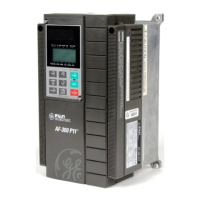11-3
Data subject to change without notice 7/07. © 2007 GE Drives
11.2 Common Specifications
Explanation
Sinusoidal wave PWM control (with V/F control, torque vector control, PG feedback vector
control (o
tion)
Maximum
fre
uenc
50 to 400 Hz variable setting
Base
fre
uenc
25 to 400 Hz variable setting
Starting
fre
uenc
0.1 to 60 Hz variable setting Holding time: 0.0 to 10.0 s
Carrier
fre
uenc
0.75 to 15k Hz (75 HP or less) 0.75 to 10k Hz (100 HP or more)
Accuracy
(stability)
Analog setting: +/- 0.2% or less of the max. frequency (at 25 +/- 10°C)
Digital Setting: +/- 0.01% or less of the max frequency (-10 to +50°C)
Setting
resolution
Analog setting: 1/3000 of max. frequency (e.g. 0.02 Hz / 60 Hz, 0.05 Hz / 150 Hz) Digital setting: 0.01
Hz (99.99 Hz or less), 0.1 Hz (100.0 Hz or more)
Output voltage at base frequency can be adjusted separately, such as 80 to 240V (200V series) or
320 to 480V (400V series)
Auto: Optimum control corresponding to the load torque.
Manual: 0.1 to 20.0 code setting (energy savings reduced torque, constant torque (strong) etc.)
0.01 to 3600s
Four accelerating and decelerating time settings are possible independent of each other by
selecting digital input signals.
In addition to linear acceleration and deceleration, either S-shaped acceleration/deceleration
(weal/strong) or curvilinear acceleration/deceleration can be selected.
Starting frequency: 0.0 to 60 Hz, braking time: 0.0 to 30.0s
Braking levels: 0 to 100%
Frequency upper and lower limiter, bias frequency, frequency gain, jump frequency, pick-up
operation, restart after momentary power failure, switching operation from line to drive, slip
compensation control, automatic energy saving operation, regeneration avoiding control, torque
limiting (2-strp), PID control, second motor switching, cooling fan ON/OFF control.
Keypad panel: Run by FWD REV keys, stop by STOP key.
Terminal input: Forward/Stop command, Reverse/Stop command, Coast-to-Stop command,
Alarm reset, acceleration/deceleration selection, multistep frequency selection, etc.
Keypad panel: setting by UP and DOWN keys
External potentiometer: External freq. Setting POT (VR) (1 to 5k ohm)
Analog input: 0 to +10V (0 to 5V), 4 to 20 mA, o to ± 10V (FWD/REV operation)
+10 to 0 (reverse operation), 20 to 4 mA (reverse operation)
UP/DOWN control: Frequency increases or decreases as long as the digital input signals are
turned on
Multistep frequency selection: Up to 15 steps are selectable by a combination of digital input
si
nals (four kinds)
Link operation: Operation by RS485 (standard)
Program operation: Pattern operation by program
Jogging operation: Jogging operation by FWD, REV key or digital input signals.
Transistor output (4 signals): Running, frequency, arrival, frequency detection, overload early
warnin
, etc.
Relay output (2 signals): Alarm output (for any fault), multi-purpose output signals
Analog output (1 signal): Output frequency, output current, output voltage, output torque, power
consum
tion, etc.
Pulse output (1 signal): Output frequency, output current, output power, output torque, power
consumption, etc.
Item
ControlOperation
Frequency setting
Operation status signal
Control Method
Output
frequency
Voltage/frequency
Characteristics
Torque Boost
Accelerating/decelerating
time
Function equipped
Operation method
DC injection braking

